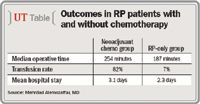Article
Neoadjuvant chemo may adversely affect radical prostatectomy outcomes
Radical prostatectomy is feasible after neoadjuvant chemotherapy, although intraoperative morbidity appears higher when men receive chemotherapy prior to surgery.

Key Points
Boston-Radical prostatectomy is feasible after neoadjuvant chemotherapy, although intraoperative morbidity appears higher when men receive chemotherapy prior to surgery, findings from a single-center, case-control study indicate.
The effects of neoadjuvant chemotherapy on perioperative outcomes were investigated by comparing a cohort of 82 men with intermediate- and high-risk prostate cancer who received chemotherapy (imatinib mesylate [Gleevec] alone or docetaxel [Taxotere] with or without estramustine [Emcyt] or bevacizumab [Avastin]) prior to surgery as a participant in a clinical trial against a control group comprised of 59 men who underwent surgery alone. All patients were operated on during the same interval (2000 to 2006) at Brigham and Women's Hospital and Beth Israel Deaconess Medical Center, Boston by the same surgeons.
Exact matching of controls was not possible because high-risk patients are usually not offered prostatectomy alone, so the control group was selected from among men with the most aggressive disease features undergoing surgery. However, analysis of baseline features revealed the neoadjuvant chemotherapy/radical prostatectomy (NCRP) group was a higher-risk cohort and was significantly less likely than the control group to have nerve-sparing surgery (~48% vs. ~90%), said co-author Mehrdad Alemozaffar, MD, a urology resident at Brigham and Women's Hospital working with Jim C. Hu, MD, MPH, and colleagues.

"Analysis of oncologic outcomes is planned after further follow-up, but our study has limitations because of its relatively small population, observational design, and imbalances in baseline characteristics between the two groups," said Dr. Alemozaffar, who presented the findings at the 2010 AUA annual meeting in San Francisco. "Elucidating the relative surgical and oncological outcomes of men receiving neoadjuvant chemotherapy prior to RP will require prospective, randomized trials, and so we look forward to the results from CALGB 90203, a phase III trial randomizing patients to neoadjuvant chemotherapy with docetaxel and estramustine followed by RP or RP alone."
Therapy still may have benefit
Neoadjuvant chemotherapy is being investigated in prostate cancer patients with intermediate- and high-risk disease as a strategy to improve their oncologic outcomes, and available data from phase I and phase II trials indicate a possible benefit based on reported recurrence-free survival rates, Dr. Alemozaffar noted.
"However, the oncologic data from these studies are still immature, and safety data show chemotherapy-treated patients have higher risks of hematologic complications, as expected, as well as an increased risk of tissue fibrosis due to a desmoplastic reaction. The latter sequela makes dissection more difficult and likely accounts for our study's finding of intraoperative ureteral and rectal injuries only in the NCRP group," he said.
Patients were included in the NCRP group if they had a Gleason grade ≥8, Gleason grade 7 with evidence of extracapsular extension on endorectal coil MRI, or PSA of 20.0 ng/mL or greater. Compared with the surgery patients, there were statistically significant differences in the NCRP group in distribution of biopsy Gleason score (Gleason ≥8, 58% vs. 41.4%) and clinical disease stage (52.4% T3 vs. 62.7% T1c); these findings were confirmed on surgical pathology. In addition, 82% of NCRP men were high risk based on D'Amico risk criteria, compared with only 48% of the controls.
Surgical margins were also significantly more likely to be positive in the NCRP group (36.6% vs. 15.3%), and considering only men with positive surgical margins, they were more likely to be extensive in the NCRP group as well.
Newsletter
Stay current with the latest urology news and practice-changing insights — sign up now for the essential updates every urologist needs.
















